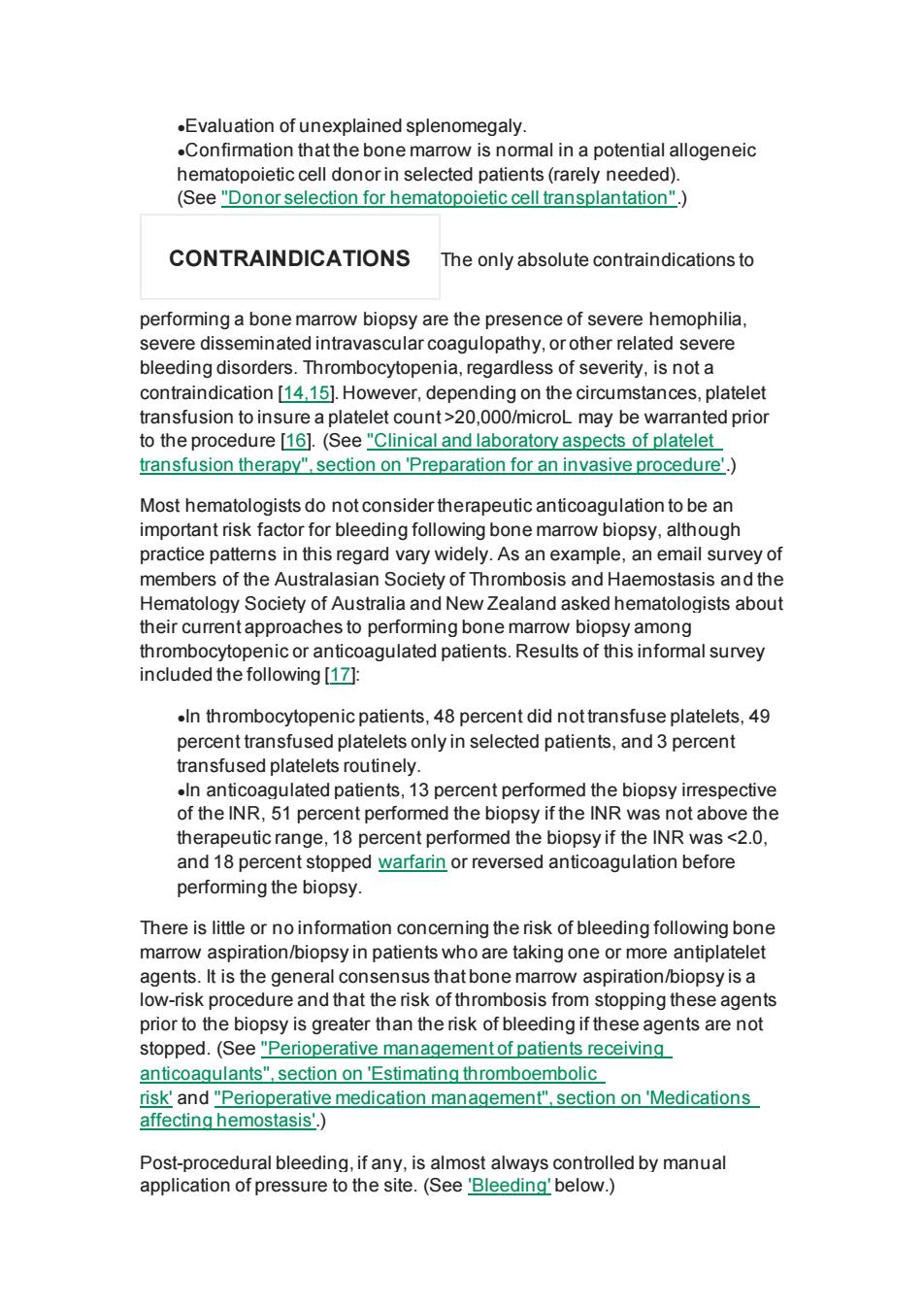正在加载图片...

.Evaluation of unexplained splenomegaly. .Confirmation tha t the bone marrov vis normal in a potential allogeneic hematopoietic cell donor in selected patients(rarely nee (See "Donor selection for hematopoietic cell transplantation". CONTRAINDICATIONS The only absolute contraindications to performing a bone marrow biopsy are the presence of severe hemophilia severe disseminated intravascular coagulopathy,or other related severe bleeding disorders.Thrombocytopenia,regardless of severity,is not a contraindication [14.15].Howe ver,depending on the circumstances.platelet transfusion to ins e a platelet count 20.00 may be warranted prio to the procedure [16].(See"Clinical and laboratory aspects of platelet transfusion therapy",section on 'Preparation for an invasive procedure'.) Most hematologists do not consider therapeutic anticoagulation to be ar important nsk factor for bleeding following bone marrow biopsy,although practice patterns in this regard vary widely.As an example,an email survey of members of the australasian society of Thrombosis and Haemostasis and the Hematology Society of Australia and New Zealand asked hematologists about their cu oaches to pe ng bone sy among thrombocytopenic or anticoagulated patients.Results of this informal survey included the following [17] .In thrombocytopenic patients,48 percent did nottransfus platelets,49 percent transfused platelets only in selected patients.and 3 percent transfused platelets routinely. .In anticoaqulated patients.13 percent performed the biopsy irrespective of the INR,51 percent performed the biopsy if the INR was not above the therapeutic range .18 percent performed the bi opsy if the e INR was<2.0 and 18 percent stopped warfarin or reversed anticoagulation before performing the biopsy. There is little or noinformation conceming the risk of bleeding following bone marrow aspiration/biopsy in patients who are taking one or more antiplatelet agents.It is the general consensus that bone marrow aspiration/biopsy is a low-risk procedure and that the risk of thrombosis from stopping these agents prior to the biopsy is greater than the risk of bleeding if these agents are not stopped.(See"P erioperative management of patients receiving anticoaqulants",section on Estimating thromboembolic risk'and"Perioperative medication management",section on 'Medications affectina hemostasis') Post-procedural bleeding,if any,is almost always controlled by manual application of pressure to the site.(See 'Bleeding'below.)●Evaluation of unexplained splenomegaly. ●Confirmation that the bone marrow is normal in a potential allogeneic hematopoietic cell donor in selected patients (rarely needed). (See "Donor selection for hematopoietic cell transplantation".) CONTRAINDICATIONS The only absolute contraindications to performing a bone marrow biopsy are the presence of severe hemophilia, severe disseminated intravascular coagulopathy, or other related severe bleeding disorders. Thrombocytopenia, regardless of severity, is not a contraindication [14,15]. However, depending on the circumstances, platelet transfusion to insure a platelet count >20,000/microL may be warranted prior to the procedure [16]. (See "Clinical and laboratory aspects of platelet transfusion therapy", section on 'Preparation for an invasive procedure'.) Most hematologists do not consider therapeutic anticoagulation to be an important risk factor for bleeding following bone marrow biopsy, although practice patterns in this regard vary widely. As an example, an email survey of members of the Australasian Society of Thrombosis and Haemostasis and the Hematology Society of Australia and New Zealand asked hematologists about their current approaches to performing bone marrow biopsy among thrombocytopenic or anticoagulated patients. Results of this informal survey included the following [17]: ●In thrombocytopenic patients, 48 percent did not transfuse platelets, 49 percent transfused platelets only in selected patients, and 3 percent transfused platelets routinely. ●In anticoagulated patients, 13 percent performed the biopsy irrespective of the INR, 51 percent performed the biopsy if the INR was not above the therapeutic range, 18 percent performed the biopsy if the INR was <2.0, and 18 percent stopped warfarin or reversed anticoagulation before performing the biopsy. There is little or no information concerning the risk of bleeding following bone marrow aspiration/biopsy in patients who are taking one or more antiplatelet agents. It is the general consensus that bone marrow aspiration/biopsy is a low-risk procedure and that the risk of thrombosis from stopping these agents prior to the biopsy is greater than the risk of bleeding if these agents are not stopped. (See "Perioperative management of patients receiving anticoagulants", section on 'Estimating thromboembolic risk' and "Perioperative medication management", section on 'Medications affecting hemostasis'.) Post-procedural bleeding, if any, is almost always controlled by manual application of pressure to the site. (See 'Bleeding' below.)